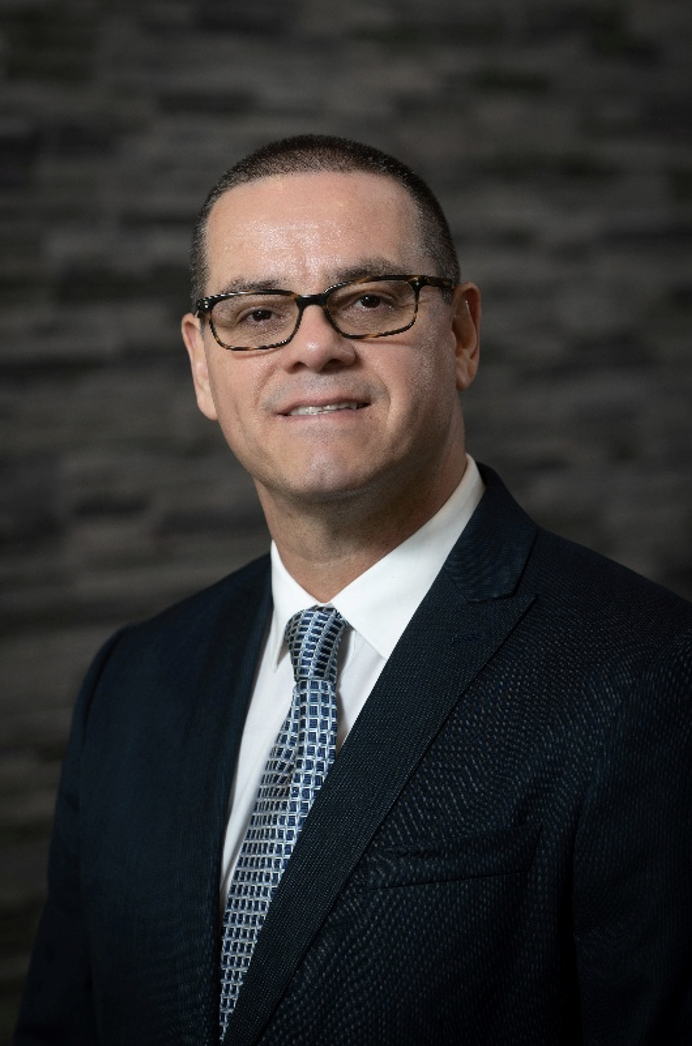Carlos E. Crespo-Hernández
Professor and Associate Dean for Research
Contact
cxc302@case.edu
216.368.1911
Millis Science Building, Room 219
http://case.edu/chem/faculty/crespo/group/
About
Faculty Office: Millis Science Building, Room 219A
http://case.edu/chem/faculty/crespo/group/
Associate Dean Office: Crawford Building, Room 715
https://artsci.case.edu/office-of-the-dean-staff/
Associate Editor for Photochemistry Photobiology:
https://onlinelibrary.wiley.com/page/journal/17511097/homepage/editorialboard.html
Interests
Analytical, Biophysical, Environmental, Organic Synthesis, Physical, and Quantum Chemistry, Photochemistry, Ultrafast Spectroscopy, Time-Resolved Electronic Spectroscopy, Chemical Dynamics and Kinetics, Small-Molecule Therapeutics, Cell Viability, Cell Bioimaging, Photodynamic Therapy, Photochemotherapy, Photomedicines, Computational Chemistry, Photonic Materials, Single-Cell Super Resolution Spectroscopy
Author Profiles
Web of Science
Google Scholars
ORCiD
Education
- Research Associate of Chemistry, The Ohio State University (2005-2006)
- NIH Postdoctoral Fellow, The Ohio State University (2002-2005)
- PhD, University of Puerto Rico, San Juan Campus, 2002
- BS, University of Puerto Rico, San Juan Campus, 1995
- Visiting Professor, University of Puerto Rico, Humacao Campus (2006-2007)
Appointments
- Associate Dean for Research, College of Arts and Sciences, Case Western Reserve University (2021-present)
- Professor of Chemistry, Case Western Reserve University (2019-present)
- Associate Professor of Chemistry, Case Western Reserve University (2014-2019)
- Co-Director of the Center for Chemical Dynamics, Case Western Reserve University (2008-2018)
- Assistant Professor of Chemistry, Case Western Reserve University (2007-2014)
Research Statement
The Crespo Research Group is committed to merit-based career development and values the diversity of our individual identities, including race, ethnicity, gender, country of origin, sexual orientation, and gender identity. We believe that celebrating our differences allows us to learn from one another as we work together to train the next generation of researchers, educators, and professionals. Our goal is to tackle challenging research problems and enhance the understanding of chemistry and related fields.
The research conducted by Professor Crespo’s group focuses on understanding the mechanisms behind light-induced phenomena in molecules, biopolymers, and cells, particularly those relevant to photochemistry and photobiology. Our primary goal is to explore these processes at the molecular level and leverage this fundamental knowledge to create applications in cancer therapy, bioimaging, and single-cell spectroscopy. Currently, we are working on developing small molecules that act as photosensitizers and photomedicines for treating cancer cells and enhancing cell bioimaging. Additionally, we are creating photoswitches and photonic materials for various applications.
The research efforts in Professor Crespo’s group are both interdisciplinary and multidisciplinary, encompassing a variety of chemistry fields (as mentioned in the Interests section above). The group emphasizes professional development, providing training for undergraduates, graduates, and postdoctoral associates in innovative research techniques and the use of state-of-the-art technologies. Students participating in these scientific activities gain expertise in a wide range of analytical techniques, including high-performance liquid chromatography, nuclear magnetic resonance, mass spectrometry, circular dichroism, fluorescence, ultraviolet-visible spectrophotometry, and time-resolved instrumentation on timescales ranging from femtoseconds to microseconds. Additionally, they learn about confocal microscopy, high-resolution and super-resolution spectroscopy, as well as computational methods for both ground and excited states. These research experiences help students integrate into mainstream scientific activities and contribute to the global scientific community.
Selected Publications
- Seth, S. K.; Acquah, C.; Levi, L.; Jockusch, S.; Crespo-Hernández, C. E. “Harnessing the Excited States of 5-(5-Phenylthiophen-2-yl)-6-Azauridine as a Three-Pronged Agent for Skin Cancer Therapy: Photodynamic Action, Cell Imaging, and Cancer Cell Inhibition”, ACS Applied Bio Materials 2025, DOI: 10.1021/acsabm.5c01035. Access article
- Hoehn, S. J.; Krul, S. E.; Seth, S. K.; Crespo-Hernández, C. E. “Structure-Photophysical Property Relationships in Non-Canonical and Synthetic Nucleobases”, Annu. Rev. Phys. Chem. 2025, vol. 76, 539-564. Access article
- Acquah, C.; Seth, S. K.; Feng, C.; Jockusch, S.; Levi, L.; Falcón-Cruz, N. V.; Li, L.; Crespo-Hernández, C. E. “dTAT1: An Unnatural Nucleoside Exhibiting Low Photocytotoxicity for Genetic Code Expansion”, J. Phys. Chem. Lett. 2025, 16, 5390-5397. Access article
- Acquah, C.; Pabis, Z.; Seth, S. K.; Levi, L.; Crespo-Hernández, C. E. “Low Cost, 3D Printed Irradiation System for In Vitro Photodynamic Therapy Experiments”, Photochem. Photobiol. 2024, 100, 530-540. Access article
- Griffith, C.; Krul, S. E.; Hoehn, S. J.; Phan, T.; Crespo-Hernández, C. E. “Structural and Electronic Factors Controlling the Efficiency and Rate of Intersystem Crossing to the Triplet State in Thiophene Polycyclic Derivatives”, Chem. Eur. J. 2024, e202402721 (1 of 10). Access article
- Ortiz-Rodríguez, L. A.; Fang, Y.-G.; Niogret, G.;Hadidi, K.; Hoehn, S. J.; Folkwein, H. J.; Jockusch, S.; Tor, Y.; Cui, G.; Levi, L.; Crespo-Hernández, C. E., “Thieno[3,4-d]pyrimidin-4(3H)-thione: An Effective, Oxygenation Independent, Heavy-Atom-Free Photosensitizer for Cancer Cells”, Chem. Sci. 2023, 14, 8831-8841. Access article
- Sharma, D.; Zagore, L. L.; Brister, M. M.; Ye, X.; Crespo-Hernández, C. E.; Licatalosi, D. D.; Jankowsky, E., “The Kinetic Landscape of an RNA Binding Protein in Cells”, Nature, 2021, 591, 152–156. Access article
- Ortiz-Rodríguez, L. A.; Hoehn, S. J.; Loredo, A.; Wang, L.; Xiao, H.; Crespo-Hernández, C. E., “Electronic Relaxation Pathways in Heavy-Atom-Free Photosensitizers Absorbing Near-Infrared Radiation and Exhibiting High Yields of Singlet Oxygen Generation”, J. Am. Chem. Soc. 2021, 143, 7, 2676–2681. Access article
- Ortiz-Rodríguez, L. A.; Crespo-Hernández, C. E., “Thionated Organic Compounds as Emerging Heavy-Atom-Free Photodynamic Therapy Agents”, Chem. Sci. 2020, 11, 11113-11123. Access article
- Ortiz-Rodríguez, L. A.; Reichardt, C.; Hoehn, S. J.; Jockusch, S.; Crespo-Hernández, C. E., “Detection of the thietane precursor in the UVA formation of the DNA 6-4 photoadduct”, Nature Commun. 2020, 11, 3599. Access article

